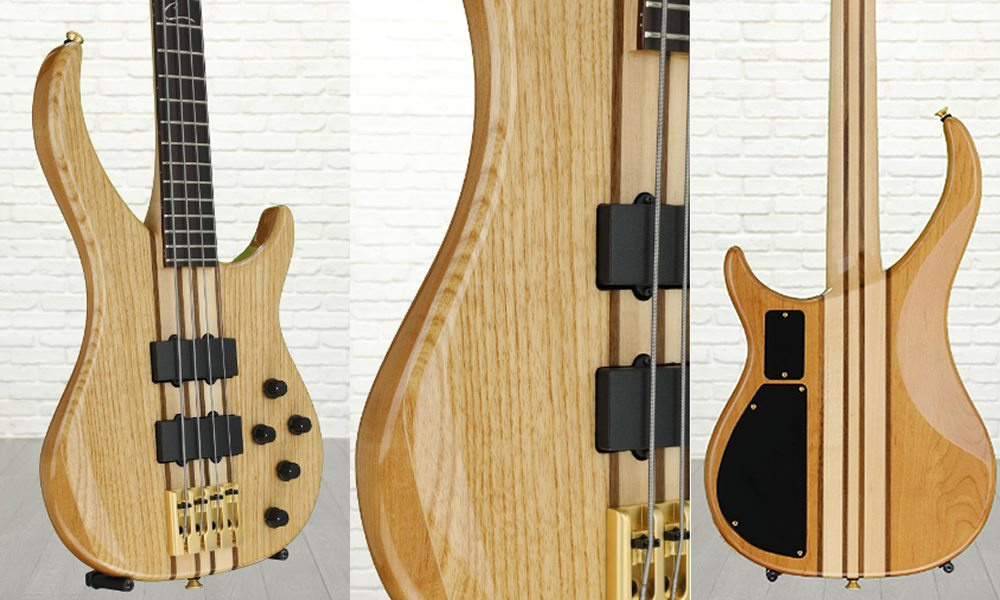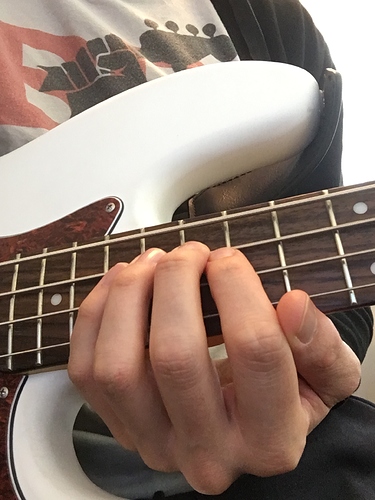I just started module 7, lesson 3, and to my dismay, it’s asking me to play on high frets. I just can’t find a position where it doesn’t hurt my wrist to play on high frets. I’ve tried sitting and standing and with the bass pointed in various directions. I’m going to put a video, but it’s not very enlightening, I don’t think. It’s this just me? Is my wrist defective or something?
So basically, @JoshFossgreen, I’m just going to need you to redo that whole lesson in another key, OK?  How about F? F is nice.
How about F? F is nice.
I remember that module and I think it actually just might be an extreme wrist position that one has to get used to gradually.
All I can do is recommend skimming through this thread Module 7 / Major Scale -- The wrist - #8 by howard
My answer won’t be better than what was already said there. Potentially worse.
After posting I picked up my bass to test it out if it has gotten better for me and it has.
Not because of practice but for me it’s a different position of the bass but not the neck which you move in the video but to shift it more towards the center.
I changed the position when starting with Module 13 to learn slap.
But now I get why strain so much in the lower frets. Fret 1-3 are really awkward for me to grip with the new position of the bass and it all seems to have to do with how straight one can hold the lower arm towards the bass or how much one has to angle it to get a fretting grip.
I love Adam Neely and have watched his video from that thread a ton. I wish I could figure out any neutral-position-ish way to get my fingers on those frets. Linking the video here for anyone who hasn’t seen it:
Developing Safe Left Hand Technique for Bass Guitar - YouTube
Hi @tamaraster
I have watched your video and I think you are being a bit harsh on your self.
I reckon over time this will improve and as you improve your dexterity, you will look back in 6 months and say to yourself this is easy.
Keep up the good work 
Cheers Brian
Yeah that Neely vid is a must-watch IMO.
I had some trouble as well with the high frets. The solution I found was to push against the body of the bass with the lower arm of my plucking hand. That way, the neck got pushed away from my body and I had easier access to the high frets.
Seems a bit strange but worked for me 
What I would recommend - and what works for me - is to NOT use the pinky at all that high up on the neck! Make do with index, middle and ring. For one thing, everything is close together up there, so no need for a wide stretch (across the frets). And, your ring finger is/should be a bit longer, helping in the stretch across the strings.
On a J or P bass (or any Fender-type neck as far as I know), this is indeed unavoidable.
Let’s not forget that @JoshFossgreen has big, long-legged spiders where we mere mortals have hands, and he’s playing a bass that is seriously better up the fretboard than a J-bass in terms of ergonomics:
Neck-thru construction certainly helps. Not having that big block you run into when trying to reach the high frets feels really good 
And it’s not just that – look at how on the Cirrus, if you venture up the fretboard, the body only begins to exist where the Jazz has completely ran out of fretboard. 
Hey @tamaraster, thanks for the video. Some good thoughts already in this thread, I’ll share some more. I don’t have an immediate “ah-ha” solution for you, but hopefully something helps:
First of all, I don’t think you’re in as bad shape as you think - you’re able to get those D and G string notes pretty decent, and the index note on the A string is okay too. Right? So it’s really just reaching the pinky onto the lower strings that’s causing the worst of it, if I’m understanding you.
It seems like you might want to mess with bass position / body position a bit - your arm looks like it’s getting a little cramped on your torso, which will limit your mobility. I think that’s (at least part of) why it helps to angle the neck up. You could also try:
- shifting the bass to your left a tiny bit more
- tilting the neck forward a bit, like you wanted to point the headstock to a point in front of you (just a very slight move in that direction), so there’s more space between your body and the back of the neck up there
If you’re gonna keep your thumb in line with your fingers rather than behind the neck like that, try to keep it in a more neutral position, resting up against your index finger. You’ve got it stretched so far out that it might be affecting the mobility of your fingers. More like this:
Any of that help?
@Gio, you have any other ideas? Things that have helped your students get comfortable at the top of the neck?
I think you covered the angles. The only other idea that I’ve seen work is mentioned by @joergkutter:
3 fingers up there can do most of the work - and once you get comfortable, finding a way to adjust into the pinky should be doable.
I really appreciate all of the advice! I’ll keep working on this while keeping it in mind and see if anything helps.
Friends! I was able to do the lesson tonight! Thanks so much for your encouragement and ideas. The main things that helped seemed to be
- @JoshFossgreen’s idea of moving my thumb all the way to the front alongside my fingers,
- Pushing the guitar further left (which I can do sitting down; not sure about standing up), and
- Accepting that it’s a little awkward and might not look smooth
Last night, I started that lesson after spending about an hour working through some rough bits* of my method book, and after a whole day at work, so when I ran into difficulty with the lesson, I didn’t have a lot of emotional resilience around it, and got a bit too upset considering this is a no-stakes, generally relaxing hobby for me.
(*I had to play like 16 measures using 11 different notes on three strings! And read them! In bass clef! Nooooooo!)
Thanks for letting us now it helped. I think I bookmark this thread/Joshs explanation. You are not the first and you won’t be the last with questions about the Module 7 - Major Scale lesson.
I also learned something. I already did the thing with the thumb sometimes because as Josh explained it felt like a more natural hand position and at the same time I had the feeling I’m cutting corners.
Now I will use that technique more liberally.
Great work @tamaraster,
As I mentioned earlier, you will look back in no time and say to yourself what was all the stress and angst about.
You’re nailing it:+1: cheers Brian
cheers Brian
Hi all! I was having the same questions for Module 7. What seems to work best for me is, if sitting, move the bass to the left leg and keep the neck more level. It’s harder to play near the headstock that way though. If standing, I find it easier if I make sure the neck is tilted up so I have room to get my hand in there. For reference, the bass I’m using is an Ibanez SR400 with 24 frets. I hope that makes sense. I’m still working on positioning. 
How did I miss this thread? @tamaraster this the same difficulty I’ve been dealing with for a few weeks now. It had been very uncomfortable for me especially on the upper frets. I’ve been twisting my poor left hand into a pretzel, especially on those low strings (E and A).
I found all that Josh said was true:
My vanity just wouldn’t allow me to sit the bass on my left leg, and that messed with my low fretting anyway. So, I discovered that tipping the neck forward like Josh suggests does wonders. If I am facing north, the neck start to turn from west to northwest. It works nicely.
I have one more thing to add that increased my comfort even more, that I just discovered recently that helped my left hand fretting and comfort on the high frets. I was watching one of my favorite guitar channels, and saw this:
It’s just a simple guitar lesson. At 40 seconds Jimmy says to make sure the guitar is “straight up and down” That is the body the guitar needs to hug your body. At the time I didn’t really think about it, until later when I picked up my bass.
I had just loosened my truss rod just a bit to try to raise the action a bit, but it just wasn’t enough, and my hand was killing me no matter how I tried to get behind the neck. Something was still wrong, and suddenly I remembered that Jimmy Paragallo video. Is this bass straight up and down? I thought, “Of course it is! It’s not laying in my lap!” The other voice in my head, “Yeah, but humor me! Sit it so straight that you can’t even see the frets, just the dots on top of the neck. You’ve been playing long enough, your fingers know where they are!”
Wow. Huge difference! Maybe I thought the bass was straight up and down, but apparently it wasn’t. Now I am able to fret all four strings on frets 9 through 12 for Josh’s finger exercise, and the best part…no pain in the back of my hand. This uncomfortable tension on the back of my hand has been plaguing me on the upper frets. This may also explain why I have no issues playing when standing with the bass hanging from my strap; the bass is oriented vertically by gravity.
With this last adjustment added to Josh’s tilt forward, I can access up to the 19th fret on the E string with my pinky ( the fender design just won’t let my hand come up any more).
I thought I’d add this little bit that I discovered. I hope it helps someone.


